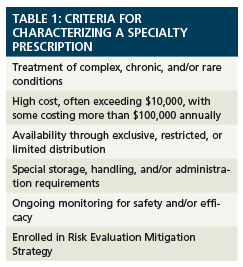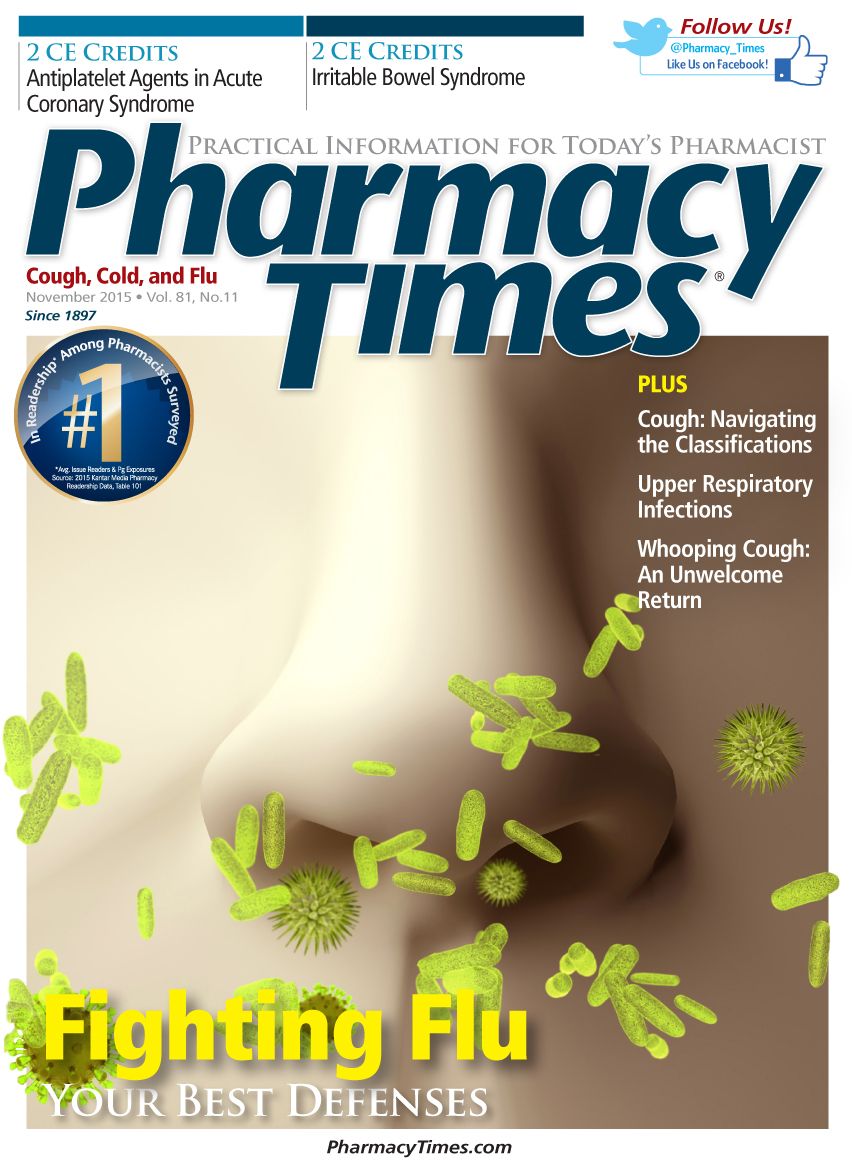Publication
Article
Pharmacy Times
A Year in Review
Author(s):
The Medicare Modernization Act, passed in 2003, is shifting the community pharmacy landscape, enabling pharmacists to use their clinical background beyond the prescription dispensing role.

The Medicare Modernization Act, passed in 2003, is shifting the community pharmacy landscape, enabling pharmacists to use their clinical background beyond the prescription dispensing role. Since the passing of the Affordable Care Act in 2010, the provision of pharmacy services continues to exponentially increase in frequency and diversity, including medication therapy management, disease management, immunizations, and specialty prescriptions.1
Specialty prescription medications are used to treat complex, chronic, and costly conditions. These medications contain ingredients with specific storage, administration, and monitoring requirements.3 Specialty prescriptions must have multiple characteristics to be properly classified as such (Table 1).2 Because of the broad range of specialty medications, this article focuses 2015 trends regarding specialty drugs for cancer, hepatitis C, and biologics.
In 2014, Healthcare Research & Analytics surveyed 128 pharmacies to find out what service(s) they provide. Fifty-seven of the 128 pharmacies stated they currently offer specialty prescription services; 32% of those 57 pharmacies started offering the services when the ACA went in to effect. Moreover, due to legislative provisions from the ACA, advancements in biotechnology, a robust drug pipeline, and growing demands for specialty therapies, it is estimated that the field of specialty prescription drugs will account for about 40% of prescription drug spending by 2016.2
Oncology
From January through July 2015, 6 medications were approved by the FDA for various cancers (Online Table 2).4 Even more exciting is the rise of a new field that will become a significant component of cancer care: immuno-oncology. With the rise of immuno-oncology, therapies given to cancer patients will activate their entire immune system rather than nonselectively targeting only cells. By immuno-oncology targeting the immune system rather than the tumor, the immune system selectively recognizes and attacks cancer cells.10
Table 2: New Oncology Drugs Approved by the FDA in 2015
Brand
Generic
Manufacturer
Approval Date
Indication
Website
Farydak
panobinostat
Novartis
February 2015
Multiple myeloma
www.farydak.com
Ibrance
palbociclib
Pfizer
February 2015
ER-positive, HER2-negative breast cancer
www.ibrance.com
Lenvima
lenvatinib
Eisai
February 2015
Thyroid cancer
www.lenvima.com
Odomzo
sonidegib
Novartis
July 2015
Locally advanced basal cell carcinoma
www.accessdata.fda.gov/drugsatfda_docs/
label/2015/205266s000lbl.pdf
Opdivo
nivolumab
Bristol-Myers Squibb
March 2015
Metastatic squamous non-small cell lung cancer
www.opdivo.bmscustomerconnect.com/
gateway
Unituxin
dinutuximab
United Therapeutics
March 2015
High-risk neuroblastoma in pediatrics
www.unituxin.com/
Hepatitis C Virus
Hepatitis C virus (HCV) infection causes inflammation of the liver due to an RNA virus, usually manifesting with symptoms such as fatigue, nausea, loss of appetite, dark urine, and jaundice. Left untreated, HCV can result in liver failure, liver cancer, and death. HCV can also trigger autoimmune disorders and other diseases such as diabetes, non-Hodgkin lymphoma, retinal complications, and thyroiditis. HCV is also the leading cause of death in those coinfected with HIV.5
Based on data from 2015, 3 million individuals in the United States are infected with HCV annually, 15,000 of whom die each year. Standard treatment used to include interferon and ribavirin; however, due to advancements in biotechnology, pegylated interferon started replacing regular interferon. Since 2011, HCV treatment has expanded (Online Table 3)6 to include protease inhibitors taken 2 or 3 times daily (a oncedaily protease inhibitor was approved in November 2013), polymerase inhibitors that can be given to patients coinfected with HIV/HCV, and combination pills offering patients with HCV an all-oral regimen (no longer requiring the need for injectable interferon and ribavirin).6
Initially, 2015 appeared to have a slow and unsettling start. In March, the FDA announced safety concerns about 2 of the newer agents, Solvadi and Harvoni (Table 3), reporting postmarketing cases of severe bradycardia when the drugs were coadministered with amiodarone.6,7 Despite these setbacks, the FDA approved the HCV medications Daklinza and Technivie this past July.
Table 3: List of FDA-Approved HCV Treatments
Brand
Generic
Mechanism of Action
Administration
Route
Approval
Year
Genotype(s)
Manufacturer
Intron-A
Interferon alfa-2b
α-interferon
Intramuscular, subcutaneous injection
1997
1
Merck
Copegus
Ribavirin
Direct-acting antiviral
Tablet
2002
1, 2, 3
Genentech
Rebetol
Ribavirin
Direct-acting antiviral
Solution
2003
Ribasphere
Ribavirin
Direct-acting antiviral
Capsule
2004
Pegasys
PEG-interferon alfa-2a
α-interferon
Subcutaneous injection
2002
1, 4
Genentech
PEG-Intron
PEG-interferon alfa-2b
α-interferon
Subcutaneous injection
2001
All
Merck
Victrelis
Boceprevir
Protease inhibitor
Capsule
2011
1
Merck
Incivek
Telaprevir
Protease inhibitor
Tablet
2011
1
Vertex
Olysio
Simeprevir
Protease inhibitor
Capsule
2013
1
Janssen
Sovaldi
Sofosbuvir
Polymerase inhibitor
Tablet
2013
1, 2, 3, 4
Gilead
Harvoni
Ledipasvir/sofosbuvir
Direct-acting antivirals
Tablet
2014
1
Gilead
Viekira Pak
Ombitasvir
NS5A inhibitor
Tablet
2014
1
AbbVie
Paritaprevir
NS3/4A inhibitor
Ritonavir
Protease inhibitor and pharmacokinetic booster for paritaprevir
Dasabuvir
NS5B inhibitor
Daklinza
Daclatasvir
NS5A inhibitor
Tablet
2015
3
Bristol-Myers Squibb
Technivie
Ombitasvir
NS5A inhibitor
Tablet
2015
4
AbbVie
Paritaprevir
NS3/4A inhibitor
Ritonavir
Protease inhibitor and pharmacokinetic booster for paritaprevir
Biologics
Approval of a biosimilar product is based on a demonstration that the product is highly similar to an already-approved biologic product (known as the reference product) with no clinically meaningful differences in safety and effectiveness from the reference product.8 The Biologics Price Competition and Innovation Act of 2009, a section of the ACA, created an abbreviated licensure pathway for biologic products shown to be biosimilar to or interchangeable with the reference product: biologics must share the same mechanism(s) of action, administration route(s), dosage form(s), and strength(s) as the reference product.
On March 6, 2015, the FDA approved the first biosimilar, Zarxio (filgrastimsndz). Zarxio is biosimilar to Neupogen (filgrastim) and carries the same indications for use. However, 2 months later, the US court of appeals blocked Novartis, the manufacturer of Neupogen, from selling Zarxio. Although the court hearing was held in June 2015, no decision on whether to resume sales of Zarxio has been made yet. Allowing Zarxio to be sold in the United States would pave the way for biosimilars to be marketed and save the United States close to $44 billion over 10 years.9
Brian J. Catton, PharmD, is a scientific communications manager for AlphaBioCom in King of Prussia, Pennsylvania. He received the Distinguished Young Pharmacist Award from the New Jersey Pharmacists Association in 2014. His topics of interest include pediatrics, disease-state management, professional development, and vaccinations.
References
- Kelly K, Rife C. Healthcare Reform: the changing role of retail and specialty pharmacy. Healthcare Research & Analytics website. https://hraresearch.s3.amazonaws.com/_media/_pdf/HRA%20The%20Changing%20Role%20of%20Retail%20and%20Specialty%20Pharmacy%20-%20White%20Paper.pdf. Published September 2014. Accessed August 3, 2015.
- James D. Top 10 trends in specialty pharmacy. Specialty Pharmacy Times website. www.specialtypharmacytimes.com/publications/industryguide/2014/specialty-pharmacy-times-industry-guide-october_2014/top-10-trends-in-specialty-pharmacy. Published October 24, 2014. Accessed August 3, 2015.
- Specialty drugs. Wellmark Blue Cross and Blue Shield website. www.wellmark.com/HealthAndWellness/DrugInformation/SpecialPrograms/SpecialtyDrugs.aspx. Published 2015. Accessed August 3, 2015.
- FDA approved drugs for oncology. CenterWatch website. www.centerwatch.com/drug-information/fda-approved-drugs/therapeutic-area/12/oncology. Accessed August 4, 2015.
- American Association for the Study of Liver Diseases, Infectious Diseases Society of America. Recommendations for testing, managing, and treating hepatitis C. HCV Guidance website. www.hcvguidelines.org/printpdf/71. Published December 19, 2014. Updated June 28, 2015. Accessed August 5, 2015.
- Advances in medications to treat hepatitis C. American Liver Foundation website. http://hepc.liverfoundation.org/treatment/the-basics-about-hepatitis-c-treatment/advances-in-medications/. Updated April 2015. Accessed August 5, 2015.
- Hepatitis B and C. FDA website. www.fda.gov/ForPatients/Illness/HepatitisBC/ucm20041759.htm. Updated July 24, 2015. Accessed August 5, 2015.
- FDA approves first biosimilar product Zarxio [news release]. Silver Spring, MD: FDA; March 6, 2015. www.fda.gov/NewsEvents/Newsroom/PressAnnouncements/ucm436648.htm. Accessed August 6, 2015.
- Dangi-Garimella S. Zarxio yet to see light of day in US market. American Journal of Managed Care website. www.ajmc.com/journals/evidence-based-oncology/2015/june-2015/zarxio-yet-to-see-light-of-day-in-us-market. Published June 5, 2015. Accessed August 6, 2015.
- European Expert Group on Immuno-Oncology. What is immuno-oncology? A guide for patients. European Cancer Patient Coalition website. www.ecpc.org/Documents/Policy&Advocacy/Immuno-Oncology/Event%2019th%20Nov%202014/IO%20patients%20leaflet.pdf. Published November 2014. Accessed August 6, 2015.







